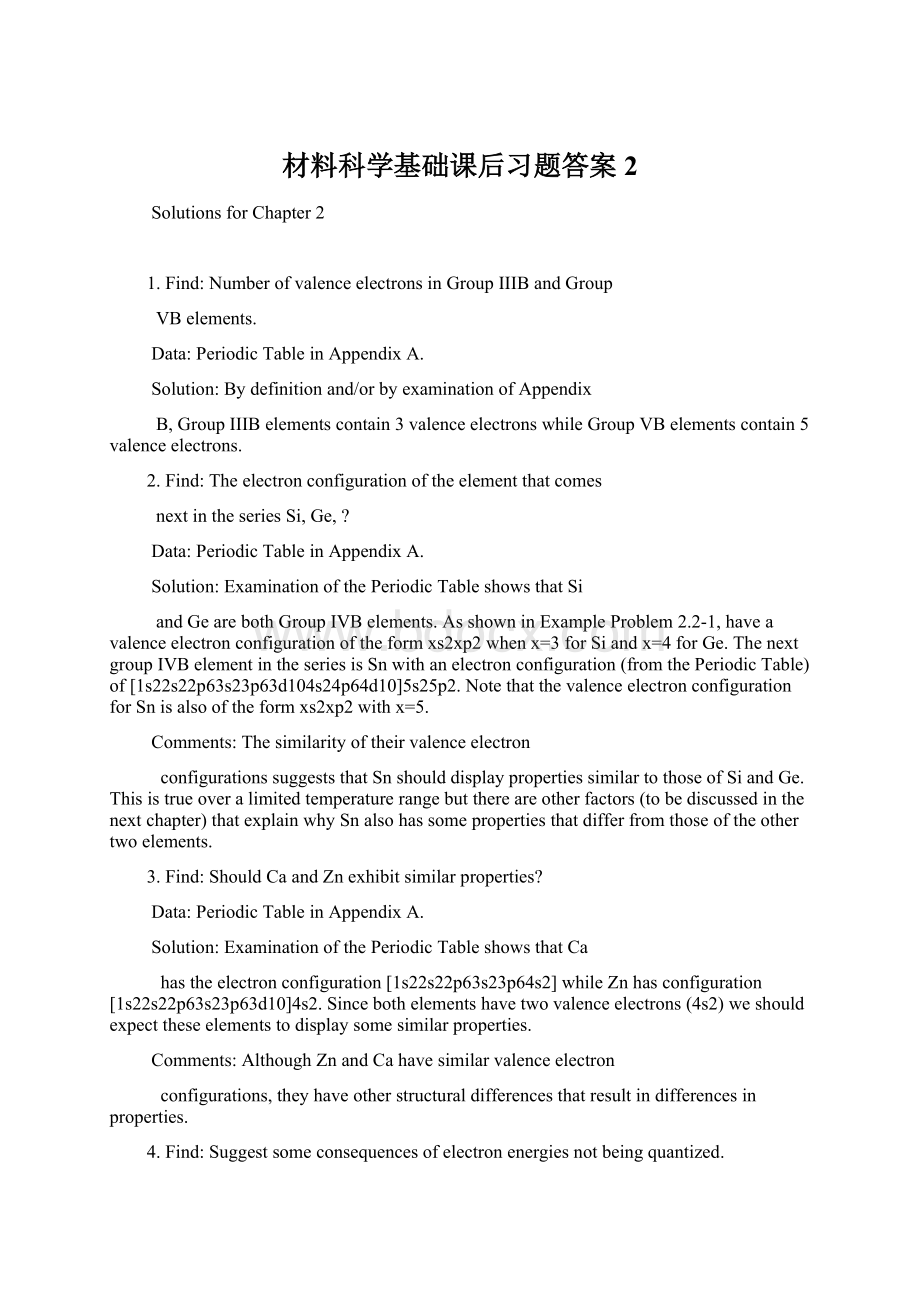材料科学基础课后习题答案2.docx
《材料科学基础课后习题答案2.docx》由会员分享,可在线阅读,更多相关《材料科学基础课后习题答案2.docx(21页珍藏版)》请在冰豆网上搜索。

材料科学基础课后习题答案2
SolutionsforChapter2
1.Find:
NumberofvalenceelectronsinGroupIIIBandGroup
VBelements.
Data:
PeriodicTableinAppendixA.
Solution:
Bydefinitionand/orbyexaminationofAppendix
B,GroupIIIBelementscontain3valenceelectronswhileGroupVBelementscontain5valenceelectrons.
2.Find:
Theelectronconfigurationoftheelementthatcomes
nextintheseriesSi,Ge,?
Data:
PeriodicTableinAppendixA.
Solution:
ExaminationofthePeriodicTableshowsthatSi
andGearebothGroupIVBelements.AsshowninExampleProblem2.2-1,haveavalenceelectronconfigurationoftheformxs2xp2whenx=3forSiandx=4forGe.ThenextgroupIVBelementintheseriesisSnwithanelectronconfiguration(fromthePeriodicTable)of[1s22s22p63s23p63d104s24p64d10]5s25p2.NotethatthevalenceelectronconfigurationforSnisalsooftheformxs2xp2withx=5.
Comments:
Thesimilarityoftheirvalenceelectron
configurationssuggeststhatSnshoulddisplaypropertiessimilartothoseofSiandGe.Thisistrueoveralimitedtemperaturerangebutthereareotherfactors(tobediscussedinthenextchapter)thatexplainwhySnalsohassomepropertiesthatdifferfromthoseoftheothertwoelements.
3.Find:
ShouldCaandZnexhibitsimilarproperties?
Data:
PeriodicTableinAppendixA.
Solution:
ExaminationofthePeriodicTableshowsthatCa
hastheelectronconfiguration[1s22s22p63s23p64s2]whileZnhasconfiguration[1s22s22p63s23p63d10]4s2.Sincebothelementshavetwovalenceelectrons(4s2)weshouldexpecttheseelementstodisplaysomesimilarproperties.
Comments:
AlthoughZnandCahavesimilarvalenceelectron
configurations,theyhaveotherstructuraldifferencesthatresultindifferencesinproperties.
4.Find:
Suggestsomeconsequencesofelectronenergiesnotbeingquantized.
Solution:
Althoughtherearemanypossibleanswerstothis
question,oneofthemoreimportantresultsmightbeabreakdownintheperiodicarrangementoftheelements.ThePeriodicTableowesitsexistencetothequantizationofenergy.Ifquantizationofenergydidnotexist,wewouldlosetheabilitytounderstandandpredictpropertiesbasedonvalenceelectronconfiguration.
5.FIND:
Howmanyelectrons,protons,andneutronsareinCu?
DATA:
FromAppendixA,theatomicnumberofCuis29andtheatomicmassis63.54g/mole.
SOLUTION:
Cuhas29electronsand29protons,eachprotonweighingabout1g/mole.Thebalanceoftheatomicmassisfromneutrons.
COMMENTS:
Elementscanhavedifferentmasses,fromhavingdifferentnumbersofneutrons.Theyarecalledisotopes.
6.FIND:
WhatistheelectronicstructureofC?
DATA:
FromAppendixA,theatomicnumberofCis
SOLUTION:
Carboniscapableof4covalentbondsofequalstrength.Justthinkofsomehydrocarbonsthatyouknow,suchasmethane,CH4.FourHbondtoacentralC.ThebondingofCmightbeexpectedtobe1s22s22p2,againfromAppendixA.Whatoccursinpracticeiscalledhybridization.Thefourelectronsinthe2sand2plevelshybridize,givingfourelectronsofequalbondstrengthcapability.Thebondsareasfarapartaspossibleinspace(tetrahedralbondangles).
7.FIND:
Describethedesirableenvironmentalstabilityofa"goldstandard".
ASSUMPTIONS:
Youwantthestandard'scriticalpropertiestobeinvariantwithtime
SOLUTION:
Goldisoneofthefewmetalswhosepuremetallicstateismorethermodynamicallytablethanitsoxide.Hence,golddoesnotoxidize.Ifitdid,thenitmightgainorloseweightwithtimeofexposuretoair.
COMMENTS:
Thisiswhygoldisfoundinnatureasnuggets,whereas,forexample,ironandaluminumarefoundasoxidesorsulfides.
8.Find:
Canpurewaterexistat-1oC?
Solution:
Yes,ifthepressureofthesystemisraised
aboveoneatmosphere,watercanexistat-1oC.
Comments:
Sincemostofourdailyexperiencesoccurat(or
near)atmosphericpressure,wetendtoforgetaboutpressureasanimportantsystemvariable.Thereare,however,manyimportantengineeringprocessesthatoccurateithersubstantiallyhigherorlowerpressures.
9.Find:
Changeinflowratewhenmolassesisheatedfrom10oC
to25oC.
Given:
Activationenergy,Q,forArrheniusProcessis
50kJ/mole.
Data:
R=8.314J/mol-K,K=oC+273
Assumptions:
FlowrateattemperatureTisgivenby
F(T)=Foexp(-Q/RT)
Solution:
Theratiooftheflowratesatanytwo
temperaturesis:
F(T1)=Foexp(-Q/RT1)=exp(-Q/R(1/T1-1/T2))
F(T2)Foexp(-Q/RT2)
F(25C)=exp(-50,000J/mol/8.134J/mol-K)(1/298K-1/283K))=2.91
F(10oC)
Atemperatureincreaseof15oCresultsinalmostafactorofthreeincreaseintheflowrateofmolasses.
10.
Find:
Changeinpolymerizationratewhentemperature
increasesby10oC.
Given:
Activationenergy,Q,forArrheniusProcessis
80kJ/mole.
Data:
R=8.314J/mole-K,K=oC+273
Assumption:
PolymerizationrateattemperatureTisgiven
byP(T)=Poexp(-Q/RT)
Solution:
Theratioofthepolymerizationratesatanytwo
temperaturesis:
P(T1)=Poexp(-Q/RT1)=exp(-Q/R(1/T1-1/T2))
P(T2)Poexp(-Q/RT2)
P(T1)=exp[-Q/R((T2-T1)/T1T2))]=exp[-Q/R(T/T1T2)]
P(T2)
Thisformoftheexpressionshowsthattheproblemcannotbesolvedwiththeinformationgiven.AknowledgeofTisnotsufficient.Wemustalsoknowthetwotemperatures.
Comments:
Whenthetemperatureincreasesfrom10oCto
20oC,therateincreasesbyafactorof3.19.Incontrast,atemperatureincreasefrom40oCto50oCresultsinarateincreaseof2.59.Thisexampleillustratesthegeneralresultthatafixedchangeintemperaturehasagreaterinfluenceonthereactionrateiftheaveragetemperatureislow.
11.
FIND:
Whyarehighqualityelectroniccableendsorcontactpointsgold-coated?
SOLUTION:
Youdonotwanttheresistanceoftheconnectiontoincreasewithtime.Oxidesaregenerallygoodelectricalinsulators.Steelpointsrustandtheoxidepreventsthemfromworking.Carpoints,forexample,needtobechangedfrequently.
COMMENTS:
Insomeelectronicdevicesaslightimpedanceincreaseduetooxideformationcancauseacircuittofailcatastrophically,destroyinganumberofcomponents.
12.
Find:
Explanationforman'sabilitytoconvertaluminum
oxidetoaluminum.
Given:
OxiderepresentsalowerenergystatethanpureAl.
Solution:
Thermodynamicsdescribesthedirectionof
spontaneouschange.Thatis,ballsrolldownhillandAlwilltransformtoAl2O3ifthekineticsarefavorableandnootherfactorsareactingonthesystem.Weknow,however,thataballcanbemoveduphillifenergyissuppliedtothesystem(i.e.ifitiscarrieduphill).Furthermore,itmayremainatahigherelevationifthereareactiva-tionbarriersassociatedwithitsreturntothelowestenergyposition.SimilarlogicappliestothereductionofAl2O3to2Al+1.5O2.Ifmansupplies(thermal)energy,themetalcanbeextractedfromitsoreandwillremaininametastablestate.However,themetalwillreturntoitsmorestableoxideatalatertimeifconditionspermit.
13.
Find:
Characteristicsofprimarybonds.
Solution:
Providedintheformofatable.
+----------------------------------------------------------+
|primary|typesof|bonding|ifsharing|
|bond|atoms|electrons|occursisit|
|type|usually|sharedor|localizedor|
||involved|transferred|delocalized|
+----------+-----------------+--------------+--------------|
|ionic|electroneg.and|transferred|---------|
||electropositive|||
+----------+-----------------+--------------+--------------|
|covalent|electronegative|shared|localized|
||(usuallywNVE>3)||sharing|
+----------+-----------------+--------------+--------------|
|metallic|electropositive|shared|delocalized|
||(usuallywNVE3)||sharing|
+----------------------------------------------------------+
14.
Find:
Primarybondtypeineachofaseriesofcompounds.
Data:
Electronegativitiesandnumbersofvalenceelectrons
foreachelementcanbeobtainedfromthePeriodicTableinAppendixA.
Element|Electronegativity|No.ofvalenceelectrons
--------+-------------------+-------------------------
O|3.44|6
Na|0.93|1
F|3.98|7
In|1.78|3
P|2.19|5
Ge|2.01|4
Mg|1.31|2
Ca|1.00|2
Si|1.90|4
C|2.55|4
H|2.20|1
||
Assumptions:
Percentioniccharacterofabondisa
functionofthedifferenceintheelectro-negativitiesoftheelementsinvolved(SeeAppendixAforconversiontable).Inametal,theaveragenumberofvalenceelectronsisgenerally3.Inacovalentsolidtheaveragenumberofvalenceelectronsisgenerally>3.
Solution:
•O2,EN=0sothatthebondisnotionic.SinceOisan
electronegativeelementandtheaveragenumberofvalenceelectronsis6,wepredictacovalentbond.
•NaF,EN=EN(F)-EN(Na)=3.98-0.93=3.05.ThisEN
correspondstoabondthatisapproximately90%ionic.
•InP,EN=EN(P)-EN(In)=2.19-1.78=0.41.Sincethis
bondisonlyabout4%ionic,wemustexaminetheaveragenumberofelectrons,NVE.SinceNVE=(3+5)/2=4,wepredictthatthebondwillbecovalent.
•Ge,EN=0sothebondisnotionic.Geisneither
stronglyelectropositiveorelectronegative,butitdoeshaveNVE=4.Thuswepredictcovalentbonding.
•Mg,EN=0sothebondisnotionic.Mgisanelectro-
positiveelementwithNVE=2.Itwillhavemetallicbonds.
•CaF2,EN=EN(F)-EN(Ca)=3.98-1.0=2.98.ThisEN
correspondstoabondthatisappproximately89%ionic.
•SiC,EN=EN(C)-EN(Si)=2.55-1.90=0.65.Sincethis
correspondstoabondthatisonly10%ionic,wemustconsiderNVE.Theaveragenumberofvalenceelectronsis(4+4)/2=4sothebondispredictedtobe